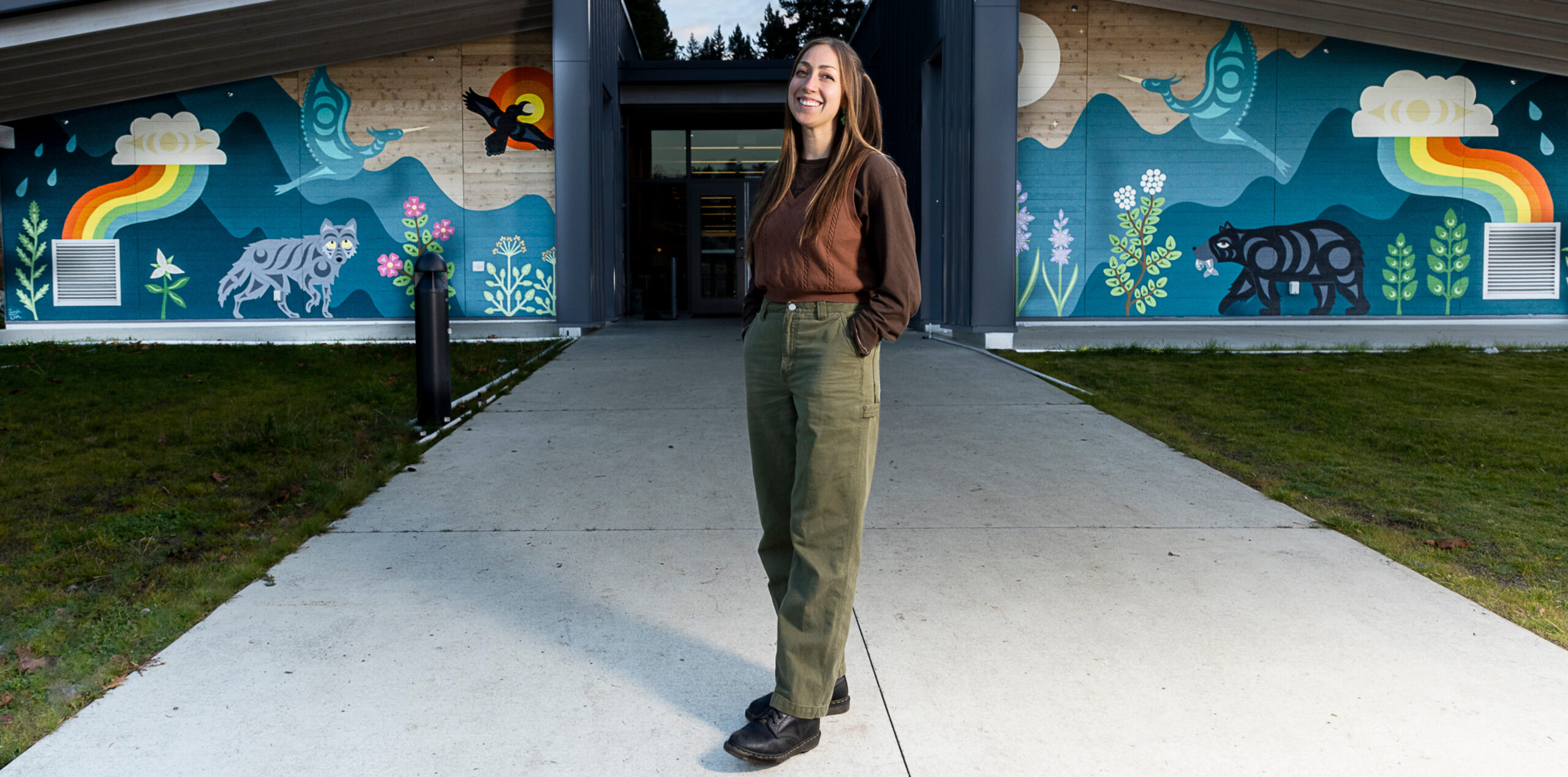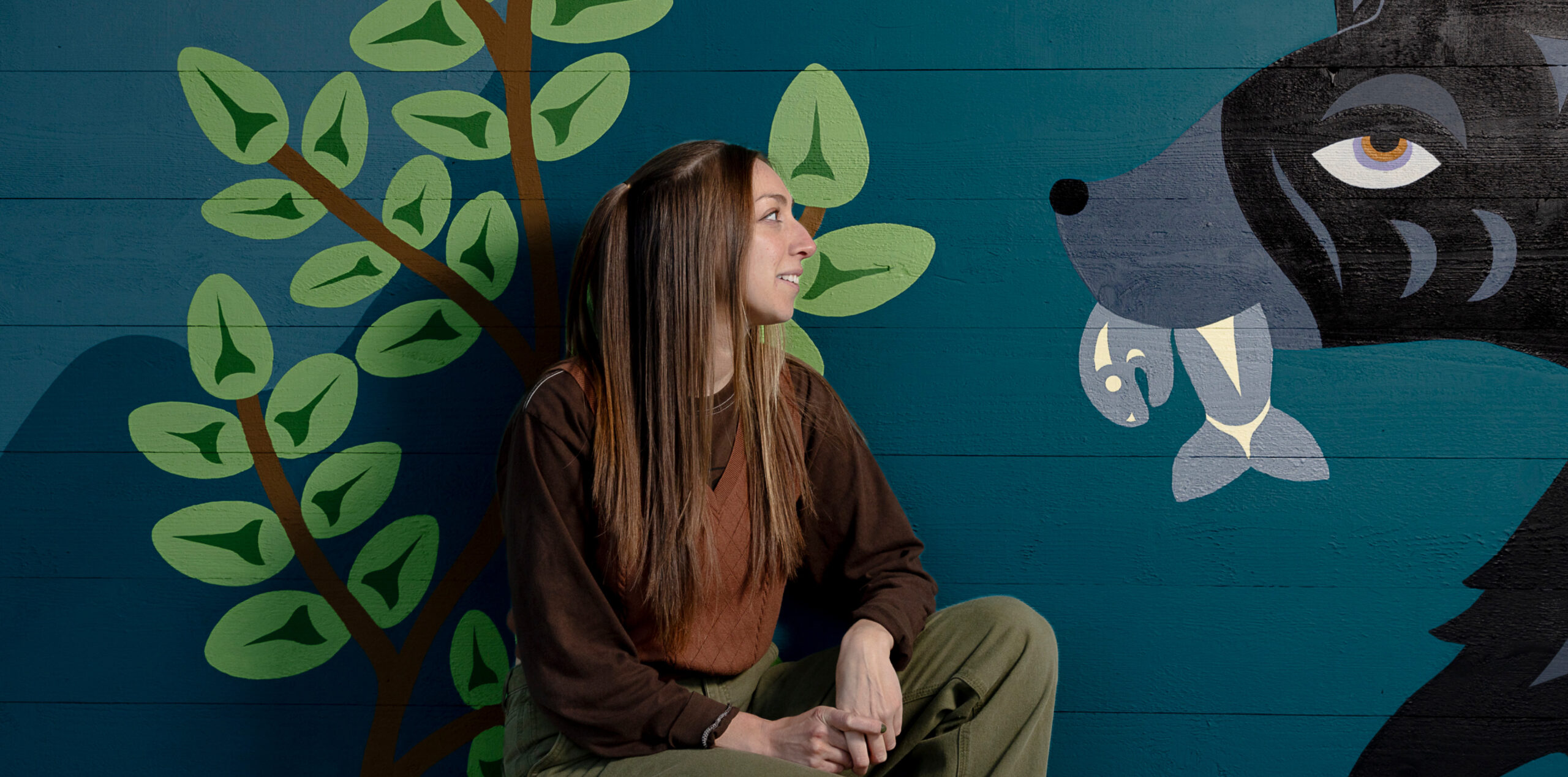by Jamila Douhaibi | photos by Leah Gray –
Sarah Jim says she was a “weird art kid” from the start. While her sisters were playing soccer, she was happy making creations just for the joy of experimenting. The style and themes of her art developed over the years and are inspired by the land and Coast Salish art.
Sarah’s childhood was a contrast of water and trees, of beauty and struggle. Growing up in W̱S͸ḴEM on the Peninsula, Sarah’s front yard was the beach and her backyard was the forest. Sarah says that she and her sisters spent the seasons playing outside and “building structurally questionable forts.” But growing up in a system that intentionally and strategically worked to erase her history and culture was hard – “of course growing up on the rez was difficult,” she says, and though she has seen marked changes over the years, her upbringing has defined how she navigates the world.
“I’ve noticed there is more W̱SÁNEĆ art and place names around the Peninsula … it makes me feel seen and that I belong,” she says. Moving away from the strictly colonial presence on this unceded land, Sarah is witnessing and creating change in how the land itself is also being taken care of. She sees environmental restoration and planting of native species as a promising start to decolonization. Looking forward five to 10 years from now, Sarah wants to be able to say that “the land is starting to remember who it is.”
Both Sarah’s art and her work on the land come from her deeply-rooted connection to this place as her home and the home of her family since time immemorial. She credits her sister Jacqueline, who was becoming fluent in the SENĆOŦEN language, for encouraging her to focus on Coast Salish art. At the same time that she started creating art in the Coast Salish style, Sarah also got a job with the PEPAKEṈ HÁUTW̱ Foundation (a W̱SÁNEĆ non-profit based out of the PEPÁḴEṈ HÁUTW̱ (Blossoming Place) Native Plant Nursery & Garden at ȽÁU,WELṈEW̱ Tribal School). While there, Sarah says that she really connected with her culture and her community, as well as increasing her knowledge of plants. The connection between her art and her environment became inseparable. She says that designing native plants with Coast Salish elements “honours the plants in a visual and meaningful way,” and has been a great way to “start discussions about environmental restoration, Indigenous land sovereignty, and cultural ways of being.”
Currently, Sarah is mostly painting murals, adorning outdoor spaces like Beckwith Park, under the Johnson Street Bridge, at the Community Fridge in Rock Bay, and at the ȽÁU, WELṈEW̱ Tribal School. Her favourite pieces include the educational signs in SMONEĆTEN and at the Horticulture Centre of the Pacific, as well as her most recent mural at Power to Be, which included a slug in the design. Sarah says that she loves “showcasing the smaller creatures like frogs, slugs, bugs and the beings that aren’t always seen and appreciated.” Just like when she was a kid, the weird and underrepresented have always called to her to be understood. “Creating something that has never existed before is also powerful medicine for me,” says Sarah.
Because of working with the PEPAKEṈ HÁUTW̱ Foundation, Sarah was inspired to continue improving the land of her people. In 2021, Sarah, along with her family, started the W̱S͸ḴEM Ivy Project, which consists of groups of volunteers that meet once a month to eradicate English ivy on the W̱S͸ḴEM reservation. As one of the last remaining forests in Tseycum, Sarah is excited with the “regeneration of native species like June plum, trilliums, oceanspray trailing blackberry,” which are flourishing now that so much ivy has been removed. Volunteers are always welcome and a great “community has formed around this seemingly simple, yet powerful activity.” Sarah hopes that the W̱S͸ḴEM Ivy Project will inspire others to restore their backyards and local parks, and says she dreams of a future where there are no invasives, but rather a healthy, biodiverse home for plants, animals and even little slugs.
There is a magic and beauty in the work that a handful of volunteers can do. Even with the damage from colonization and invasive species, Sarah is extremely hopeful and says that there is a power in “knowing that our small actions can make a difference when we work together.” Look for Sarah’s murals around the city and discover how she weaves plants and creatures into her art, and how her work is redefining how we view our environment and create community.
For more information visit: www.wsikemivyproject.com or @wsikemivyproject on Instagram, and www.sarahjimstudio.com or @sarahjimstudio on Instagram.





